Rod Bending Practices (Bend the bar, but not the rules)
"Rod Bending" - forms an integral and important role in reinforcement of RCC slabs and columns.
- it adds strength and load bearing capacity to the slabs in building
- it improves the performance of columns under strong earthquake shaking.
Purpose of article: Overview of basic rod bending work practices
Issue: Since 2000s, nature of hiring labour for a building construction work is mostly CONTRACT basis, not daily-wage basis. Over a period of time, it changed the attitude of workers to complete the work as quickly as possible to gain maximum profit from contract work.
As rod bending work is not visible outside(after RCC is done) and involves some technical know-how to verify the work, builders/individuals don't put much emphasis to cross-check the work done by rod bending workers. So they are deliberately ignoring some practices, to reduce the amount of work and thereby completing work quickly. In the long run, this can have serious consequences on strength and longevity of the building.
Below are some of the basic rod bending work practices ---
- it adds strength and load bearing capacity to the slabs in building
- it improves the performance of columns under strong earthquake shaking.
Purpose of article: Overview of basic rod bending work practices
Issue: Since 2000s, nature of hiring labour for a building construction work is mostly CONTRACT basis, not daily-wage basis. Over a period of time, it changed the attitude of workers to complete the work as quickly as possible to gain maximum profit from contract work.
As rod bending work is not visible outside(after RCC is done) and involves some technical know-how to verify the work, builders/individuals don't put much emphasis to cross-check the work done by rod bending workers. So they are deliberately ignoring some practices, to reduce the amount of work and thereby completing work quickly. In the long run, this can have serious consequences on strength and longevity of the building.
Below are some of the basic rod bending work practices ---
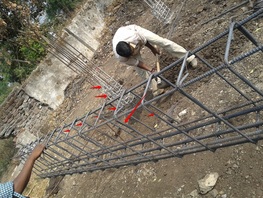 Rings/stirrups for columns and rods
Rings/stirrups for columns and rods
Practice-1: Spacing of rings/stirrups - Rings/stirrups are placed around column or beam rods to keep them united. The major purpose of them is to handle the shake generated during earthquakes and make sure rods won't get separated. The distance between rings should be as per structural engineer drawing.
In Practical Work: Most abused practice by the workers - put more spacing between rings than suggested. It reduces number of rings to be prepared by workers. Need to be very cautious with ring spacing.
In Practical Work: Most abused practice by the workers - put more spacing between rings than suggested. It reduces number of rings to be prepared by workers. Need to be very cautious with ring spacing.
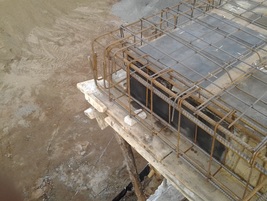 L-bend for beam rods at end
L-bend for beam rods at end
Practice-2: Beam rods at the end should have L-bend (as per structural engineer drawing). This gives strength and load bearing capacity to the beam.
In Practical Work: This is also deliberately ignored practice. As it requires more effort, workers tend to ignore this.
In Practical Work: This is also deliberately ignored practice. As it requires more effort, workers tend to ignore this.
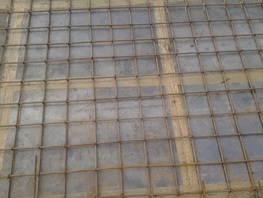 Spacing of rod mats
Spacing of rod mats
Practice-3: Spacing of the rods - In floor mat, distance between the rods should be as per design drawing.
In Practical Work: Workers tend to increase distance between the rods. It will automatically reduce the number of rods required for mat. And the funny part is, workers say that they are reducing steel consumption and helping us :)
In Practical Work: Workers tend to increase distance between the rods. It will automatically reduce the number of rods required for mat. And the funny part is, workers say that they are reducing steel consumption and helping us :)
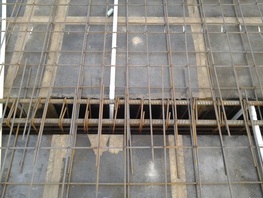 Negative/Extra rods
Negative/Extra rods
Practice-4: Negative/extra rods should be placed where crank doesn't come and only bottom layer rod exists at the end of floor mats. This is useful to reduce shear generated during temperature changes.
In Practical Work: Workers tend to forget to put these rods at all places. Need to cross-check this requirement at all positions.
In Practical Work: Workers tend to forget to put these rods at all places. Need to cross-check this requirement at all positions.
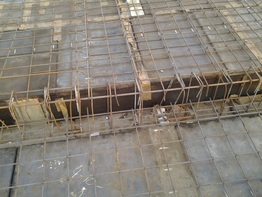 Mat rods L-bend
Mat rods L-bend
Practice-5: Mat rods should be L-bend into beam at the end of rod. For this, workers need to cut rod little more long than mat measurement and create L-bend into beam.
In Practical Work: Workers will cut the rods to exact size of mat measurement and thereby no need of L-bend. Even if longer rod comes, they will ignore to make L-bend and leaves as it is.
In Practical Work: Workers will cut the rods to exact size of mat measurement and thereby no need of L-bend. Even if longer rod comes, they will ignore to make L-bend and leaves as it is.
 Usage of wired brickets for beams
Usage of wired brickets for beams
Practice-6: (This is not associated with rod bending work. Tapi mestri has to prepare).
Issue: Small Cement-Mortar bricks (called Brickets) are kept between beam rods and centring basement, so that beam steel rods are covered by concrete on all sides. If brickets are not tied to rods, they tend to move away from positions.
Solution: Put binding wire into brickets while preparing them. Rod bending workers will tie those brickets to rods using binding wire.
Issue: Small Cement-Mortar bricks (called Brickets) are kept between beam rods and centring basement, so that beam steel rods are covered by concrete on all sides. If brickets are not tied to rods, they tend to move away from positions.
Solution: Put binding wire into brickets while preparing them. Rod bending workers will tie those brickets to rods using binding wire.
